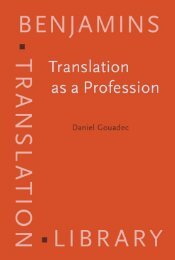Constructing a Sociology of Translation.pdf
Constructing a Sociology of Translation.pdf
Constructing a Sociology of Translation.pdf
- No tags were found...
You also want an ePaper? Increase the reach of your titles
YUMPU automatically turns print PDFs into web optimized ePapers that Google loves.
188 Daniel Simeoniapparent in English-speaking countries and in other places around the world thanin continental Europe. It is in a European context after all that novel approaches totranslation were able to develop in the late 1990s in ways that made it amenable tothe sociological discipline. Furthermore, where signs <strong>of</strong> interest for sociologicaltheory have turned up in translation studies in places other than Europe, it was<strong>of</strong>ten at the instigation <strong>of</strong> scholars originally trained and active in, or with strongpersonal connections to the European tradition. Finally, the sociological modelsthat have inspired this renewal <strong>of</strong> interest were derived from European works, inparticular, the kind <strong>of</strong> social thought associated with the works <strong>of</strong> Pierre Bourdieuand Norbert Elias.This contextualization provides a key to exploring differences <strong>of</strong> appreciationand judgment in the increasingly varied scholarly work developing here and therein the international field <strong>of</strong> translation studies. Among the most apparent dividestoday is the one between, on the one hand, an aggregate <strong>of</strong> European practices <strong>of</strong>scholarship (whatever differences exist internally among them) and, on the other,the vast expanse <strong>of</strong> work developing elsewhere, impelled by the extraordinarypressures brought about by the spread <strong>of</strong> the cultural studies movement on NorthAmerican campuses and, outward from there, wherever world Englishes prevail:Australia, Canada, India, South Africa, Hong Kong etc. and, in part, England. Inthis particular geopolitical context, virtually all disciplines – history, anthropology,political science, geography etc., as well as the academic study <strong>of</strong> translation– have incorporated elements <strong>of</strong> the cultural studies movement. Mappingthat circulation <strong>of</strong> ideas and the resulting practices in terms <strong>of</strong> the methods beingused is not easy, but it is an indispensable step on the long and winding road <strong>of</strong>conceptualizing translation as an original object <strong>of</strong> study. For one thing, the institutionalmap does not coincide with the more complex positions <strong>of</strong> scholars activein those institutions. Secondly, it is always questionable to rationalize differencesamong scholarly ways <strong>of</strong> thinking in terms <strong>of</strong> aggregates, whether in terms<strong>of</strong> national or in larger, regional blocks. The risk is great also to see a return to essentialismin such homogenized groupings. But this is no reason why a comparativeanalysis should not be attempted along those lines, in order to make sense <strong>of</strong>the different approaches to method in our field. Ideally, we would obtain a kind<strong>of</strong> Homo academicus <strong>of</strong> translation studies, applicable beyond national fields. Themap need not be fixed. Indeed, it constantly evolves.Meanwhile, to understand the logic behind those intellectual linkages andruptures, I have found it useful to think in terms <strong>of</strong> “scholarly localisms”. Consistently,the history <strong>of</strong> disciplines in the English-speaking world has differed fromthat <strong>of</strong> their continental European counterparts. With the English language nowachieving status <strong>of</strong> lingua franca, we might think that a convergence <strong>of</strong> sorts is
















